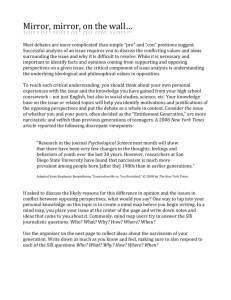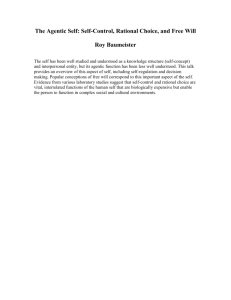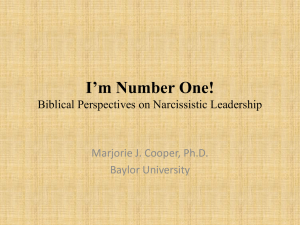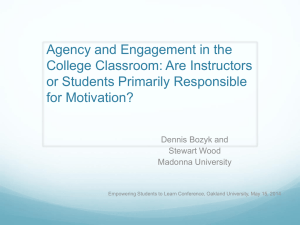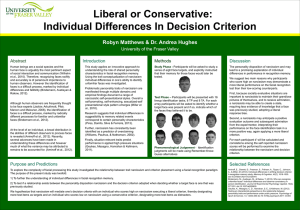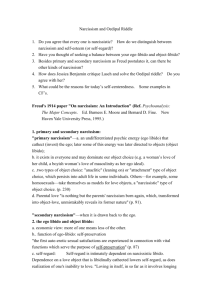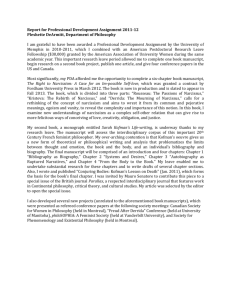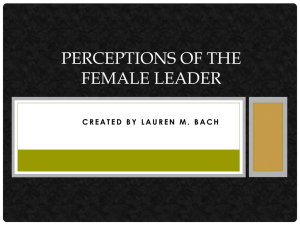- ePrints Soton
advertisement
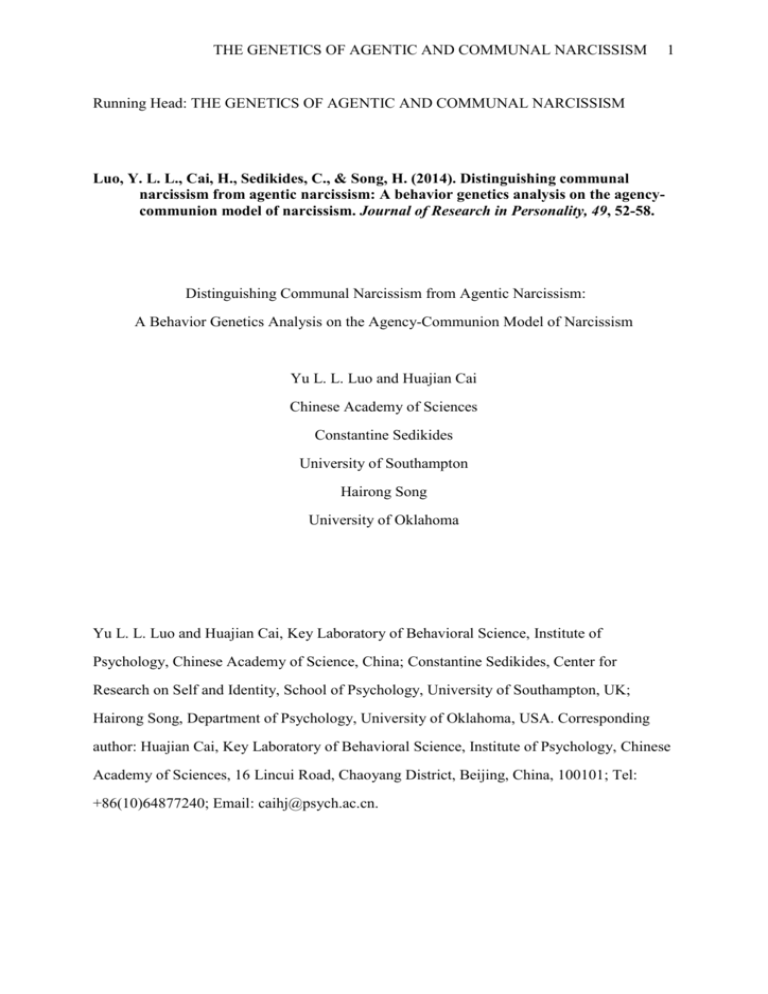
THE GENETICS OF AGENTIC AND COMMUNAL NARCISSISM 1 Running Head: THE GENETICS OF AGENTIC AND COMMUNAL NARCISSISM Luo, Y. L. L., Cai, H., Sedikides, C., & Song, H. (2014). Distinguishing communal narcissism from agentic narcissism: A behavior genetics analysis on the agencycommunion model of narcissism. Journal of Research in Personality, 49, 52-58. Distinguishing Communal Narcissism from Agentic Narcissism: A Behavior Genetics Analysis on the Agency-Communion Model of Narcissism Yu L. L. Luo and Huajian Cai Chinese Academy of Sciences Constantine Sedikides University of Southampton Hairong Song University of Oklahoma Yu L. L. Luo and Huajian Cai, Key Laboratory of Behavioral Science, Institute of Psychology, Chinese Academy of Science, China; Constantine Sedikides, Center for Research on Self and Identity, School of Psychology, University of Southampton, UK; Hairong Song, Department of Psychology, University of Oklahoma, USA. Corresponding author: Huajian Cai, Key Laboratory of Behavioral Science, Institute of Psychology, Chinese Academy of Sciences, 16 Lincui Road, Chaoyang District, Beijing, China, 100101; Tel: +86(10)64877240; Email: caihj@psych.ac.cn. THE GENETICS OF AGENTIC AND COMMUNAL NARCISSISM 2 Abstract This article examined the genetic and environmental bases of the newly proposed agency-communion model of narcissism. The model distinguishes between agentic narcissism and communal narcissism. The sample comprised 304 pairs of twins. Genes explained 47% and 25% of the variance in agentic and communal narcissism, respectively; shared environments contributed 0% and 15%, respectively, to agentic and communal narcissism, with non-shared environments accounting for the remaining portions. Although some common genes and environments influenced agentic and communal narcissism simultaneously, most genetic (68%) and environmental (94%) influences on agentic and communal narcissism were unique. These findings provide novel evidence for the theoretical plausibility of communal narcissism as well as its relatedness to and distinctiveness from agentic narcissism, supporting the agency-communal narcissism model. Keywords: narcissism; agentic narcissism; communal narcissism; twin study; behavior genetics THE GENETICS OF AGENTIC AND COMMUNAL NARCISSISM 3 Distinguishing Communal Narcissism from Agentic Narcissism: A Behavior Genetics Analysis on the Agency-Communion Model of Narcissism 1. Introduction Narcissism continues to fascinate scholars and the public alike. Normal (i.e., nonclinical) individuals high in narcissism view themselves as action superheroes. They boast that, by deed of their superior authority, competence, and leadership skills, the world would be a better-run place if they were to govern it (Morf, Horvath, & Torchetti, 2011). They manifest agentic narcissism. Another brand of normal narcissists views themselves as quaint saints. They boast that, by deed of their superior helpfulness, kindness, and caring, the world would be at peace and free of poverty if they were to save it (Gebauer, Sedikides, Verplanken, & Maio, 2012). They manifest communal narcissism. We engage in a behavior genetics analysis of agentic and communal narcissism in an effort to differentiate and clarify these two constructs. Narcissism is considered a trait high on agency (e.g., competence, ambition, influence, uniqueness), but low on communion (e.g., interpersonal warmth, affiliation, nurturance, morality) (Bakan, 1966; Paulhus & John, 1998; Wiggins, 1991). Stated otherwise, individuals high on agentic narcissism display soaring grandiosity on agentic domains (e.g., intelligence, extraversion, dominance, attractiveness), but not on communal domains (e.g., agreeableness, dependability, team membership, getting along), and they do so both in Western cultures (Back, Schmuckle, & Egloff, 2010; Horton & Sedikides, 2009; Sedikides, Rudich, Gregg, Kumashiro, & Rusbult, 2004) and in Eastern cultures (Cai, Kwan, & Sedikides, 2012; Foster, Campbell, & Twenge, 2003; Hepper, Sedikides, & Cai, 2013). Several theoretical statements have purported to account for this “superhero” (Paulhus, 2002) phenomenon. The selfperception bias model holds that narcissism reflects an egoistic bias, which is part of an agentic value system, but not a moralistic bias, which is part of a communal value system (Paulhus & John, 1998). Self-regulatory models posit that narcissism, as a self-regulating system, is marked by strong self-orientation but weak other-orientation (Campbell, 1999; Morf & Rhodewalt, 2001). The agency model regards agentic over communal concerns as a basic element of narcissism (Campbell, Brunell, & Finkel, 2006; Campbell & Foster, 2007). THE GENETICS OF AGENTIC AND COMMUNAL NARCISSISM 4 These agency-agency models have in common the proposition that individuals high on agentic narcissism satisfy core self-motives (i.e., grandiosity, self-esteem, power, entitlement) through agentic means or in the agentic domain. In contrast, individuals high on the newly identified communal narcissism satisfy the same four core self-motives through communal means or in the communal domain (Gebauer et al., 2012). According to the agency-communion model, communal narcissists (cf. “saints;” Paulhus, 2002) assert their superiority in the communal (and not agentic) domain, by exaggerating, for example, their communal characteristics (e.g., helpfulness, caring) and their knowledge of communal topics (e.g., humanitarian aid organizations) (Gebauer et al., 2012). Evidence for communal narcissism exists both in Western culture (Gebauer et al., 2012) and in Eastern culture (Gebauer, Lei, Cai, Sedikides, & Gaertner, 2013). The construct of communal narcissism in rooted in the interpersonal circle model (Leary, 1957), interpersonal circumplex models (for reviews see: Gurtman, 2009; Horowitz et al., 2006), and clinical perspectives on narcissism such as the Pathological Narcissism Inventory (Pincus et al., 2009) which includes a self-sacrificing self-enhancement subscale. In summary, previous, albeit somewhat preliminary, research has suggested that (a) individuals exhibiting communal narcissism share core self-motives with those exhibiting agentic narcissism, and (b) the construct of communal narcissism is distinct from the construct of agentic narcissism (Gebauer et al., 2012). We sought to clarify further these two constructs by differentiating between them via behavior genetics methodology. Specifically, we tested the agency-communion model by investigating genetic as well as environmental bases of agentic and communal narcissism: we assessed communal and agentic narcissism simultaneously in a twin study. Previous work has pointed to the heritability of agentic narcissism as well as considerable environmental influences from non-shared environments (Vernon, Villani, Vickers, & Harris, 2008), and, as a first goal, we gauged the replicability of this finding in a Chinese sample. More importantly, we formulated several novel hypotheses. If the agency-communion model is genetically sound, we would expect to observe that: (a) both agentic and communal narcissism are heritable, with considerable non-shared environmental influences (Hypothesis THE GENETICS OF AGENTIC AND COMMUNAL NARCISSISM 5 1); (b) agentic and communal narcissism share some common genetic and non-shared environmental bases (Hypothesis 2); and (c) both agentic and communal narcissism have unique genetic as well as non-shared environmental sources (Hypothesis 3). The previous relevant study (Vernon et al., 2008) found no significant shared environmental effects on agentic narcissism. Therefore, we also expected insubstantial influences of shared environments on agentic and communal narcissism in the present investigation. To test these hypotheses, we assessed genetic and environmental influences on agentic and communal narcissism by testing the univariate genetic model independently. Subsequently, we used the bivariate genetic model to analyze the genetic and environmental bases of the relation between agentic and communal narcissism. 2. Method 2.1 Participants Participants were 304 twin-pairs sampled from the Beijing Twin Study (BeTwiSt). Twins in the BeTwiSt are socio-demographically representative of Beijing adolescents (Chen et al., 2013). The ages of the twins in our sample ranged from 15-27 years (M = 18.29, SD = 1.96; 55.9% female). Of them, 152 pairs were monozygotic (MZ) and 152 pairs were dizygotic (DZ; 94 same-sex, 58 opposite-sex). We used DNA testing, with classification accuracy approaching 100%, to determine zygosity for 95% of the twin-pairs. For the remaining 5% of twin-pairs, we established zygosity with a combination of parent-reports and children self-reports of co-twin physical similarity and frequency of confusion—tests that feature predictive accuracy of 90.6% (Chen et al., 2010). The data of one sibling of a DZ twin pair were missing and thus excluded in further analyses. Ethical approval for the study was provided by the ethics committee of the Institute of Psychology, Chinese Academy of Sciences. We obtained written consent from the twins and their parents before testing commenced. 2.2 Measures We measured agentic and communal narcissism with the Narcissistic Personality Inventory (NPI) and the Communal Narcissism Inventory (CNI), respectively. Participants THE GENETICS OF AGENTIC AND COMMUNAL NARCISSISM 6 completed these inventories, along with other measures irrelevant to the purposes of this research, on a computer in a private room. We used translation and back-translation procedures to ensure language equivalence. The NPI (Raskin & Terry, 1988) reflects individual differences on agentic narcissism. This inventory comprises 40 items. Each item includes a pair of statements, one narcissistic and one non-narcissistic. Example pairs are: “I have a natural talent for influencing people” (narcissistic statement) versus “I am not good at influencing people” (non-narcissistic statement); “I prefer to blend in with the crowd” (non-narcissistic statement) versus “I like to be the center of attention” (narcissistic statement). The NPI has been successfully used in Chinese samples (Cai et al., 2012; Kwan, Kuang, & Hui, 2009). For each item, participants indicate whether the narcissistic or non-narcissistic statement describes them better. We coded the narcissistic statement choice as 1 and the non-narcissistic statement choice as 0. We proceeded to calculate the sum item score for each participant (α = .81)1. The CNI (Gebauer et al., 2012) reflects individual differences on communal narcissism. This inventory comprises 16 items descriptive of communal grandiose self-views. Examples are: “I am the most helpful person I know” and “I am going to bring peace and justice to the world” (1 = disagree strongly, 7 = agree strongly). The CNI has been successfully used in Chinese samples (Gebauer et al., 2013). We proceeded to calculated the mean item score for each participant (α = .87). 2.3 Analyses By comparing the resemblance between MZ and DZ twin-pairs on observed trait(s), we can decompose variance within a trait or covariance between traits into additive genetic, 1 The NPI has been widely used as a single-dimension construct (Cai et al., 2012; Foster et al., 2003; Gregg & Sedikides, 2010; Gebauer et al., 2012; Back et al., 2010), but also as a multiple-dimension construct (Ackerman et al., 2011; Brown, Budzek, & Tamborski, 2009; Cain, Pincus, & Ansell, 2008). Given these, in assessing the agency-communion model, we test models that treat NPI as whole and also based on dimensions. We expected for the results to be consistent with the hypotheses regardless of our data analytic approach. We include the method and results for these additional analyses in Supplementary Materials. THE GENETICS OF AGENTIC AND COMMUNAL NARCISSISM 7 shared environmental, and non-shared environmental (also including measurement error) effects. MZ twins are 100% genetically identical, whereas DZ twins are on average 50% identical for additive genetic effects. In the case of twins reared together, a higher MZ twin correlation than DZ twin correlation suggests that the observed trait is heritable. The term “heritability” denotes the proportion of the variance of a trait (or the covariance between traits) explained by the genetic effects. Whereas a shared environment contributes to the similarity of twins growing up in the same family, a non-shared environment is unique to each individual. We used univariate and bivariate models implemented in the OpenMx library (Boker et al., 2012) of the R statistical computing environment (R Development Core Team, 2012) to estimate heritability and environmental effects. We used univariate models to partition variances of the NPI and CNI separately into additive genetic (A), shared environmental (C), and non-shared environmental (E) components. We first tested a full ACE model by comparing it to a saturated model with free covariance and means and variances constrained to be equal across twin and zygosity status. Then, we tested three sub-models: AE model (C removed), CE model (A removed), and E model (both A and C removed), with the full ACE model serving as comparison. We used the bivariate Cholesky decomposition model to parameterize the covariance between the NPI and CNI into “common factors” (A1, C1, E1) that influence both measures, and into “specific factors” (A2, C2, E2) unique to the CNI (Figure 1.a) or the NPI (Figure 1.b).2 The Cholesky procedure is similar to hierarchical regression analysis, through which the independent contribution of predictors entered later is assessed after controlling for the predictors entered first. We tested two Cholesky models: the NPI-CNI model (Figure 1.a) and 2 We chose the Cholesky model, because it allowed us to assess the unique influences of genetic and environmental factors on agentic narcissism and (separately) on communal narcissism. In addition, we examined the common pathway model, which had 13 parameters and, obviously, was less parsimonious than the Cholesky model which had 11 parameters. Both the AIC and BIC values were higher for the common pathway model (AIC = 823.54, BIC = -3633.18) than for the Cholesky model (AIC = 821.46, BIC = -3638.97). Therefore, the Cholesky model was preferable both theoretically and statistically. THE GENETICS OF AGENTIC AND COMMUNAL NARCISSISM 8 the CNI-NPI model (Figure 1.b). In the NPI-CNI model, we entered the NPI first and the CNI later, so that we could examine the unique influences of genetic and environmental factors on the CNI. In the CNI-NPI model, we entered the CNI before the NPI, so that we could examine unique influences of genetic and environmental factors on the NPI. In both models, we could estimate genetic, shared, and non-shared environmental effects on the NPI and CNI by using the model paths. We could also estimate the bivariate heritability, bivariate shared environmental effect, and bivariate non-shared environmental effect, which represent three distinct sources of the phenotypic correlation between the NPI and the CNI. In both bivariate analyses, we tested the full ACE model and models nested within it, that is, the AE, CE, and E models. We used three model fit indices: the change in chi-square (χ2), Akaike’s Information Criterion (AIC; Akaike, 1987), and Bayesian Information Criterion (BIC; Raftery, 1995). The change in chi-square test has been commonly employed for model comparison and selection when one model is nested within the other one. A significant chi-square difference indicates that the nested model fits more poorly than the full model, leading to retaining the full model; otherwise, the nested model with fewer parameters is considered a better-fit model in terms of parsimony (Bollen, 1989; Kline, 1998). Both AIC and BIC are useful in model selection, with lower values indicating better fit. In model selection, Raftery (1993) suggested that a BIC difference of 5 is indicative of “strong evidence” that one model is superior to another, while a difference of 10 is indicative of “conclusive evidence.” Ultimately, the better-fit model received due consideration (Kline, 1998). 3. Results 3.1 Descriptive Statistics Table 1 shows summary scores and standard deviations for agentic and communal narcissism. Consistent with Gebauer et al. (2012), communal narcissism was moderately correlated with agentic narcissism, r(df = 303) = .40, p < .001, suggesting that they are related yet distinct constructs. (Note that we estimated this correlation from siblings that we randomly selected from every twin pair.) THE GENETICS OF AGENTIC AND COMMUNAL NARCISSISM 9 Multiple regressions, with NPI and CNI scores as criteria, showed that neither sex nor age significantly predicted the narcissism measures (βs: -0.06~0.02, ps > 0.1). Nevertheless, because twins are perfectly correlated for age and same-sex twins are perfectly correlated for sex, variation associated with age or sex may inflate the correlation between twins. Following standard practice, we corrected all measures for age and sex effects using a regression procedure, and we saved standardized residuals for genetic analyses (McGue & Bouchard, 1984). For each measure, based on the standardized residuals, we excluded from genetic analyses participants who had scored 3 SD above the mean sample value (< 0.7%). Thus, we excluded one participant’s NPI score and two participants’ CNI scores. The final sample that we used in the formal analyses included 152 MZ twin pairs and 150 DZ pairs for the NPI, and 151 MZ pairs and 150 DZ pairs for the CNI (Table 1). In model fitting, we used all available data to increase statistical power, even if the data from several twin pairs were not pairwised. 3.2 Univariate Analyses First, we examined the heritability of agentic and communal narcissism by conducting two univariate analyses. We present the relevant twin intraclass correlations in Table 1. Agentic narcissism. The similarity between MZ twins was much higher than that between DZ twins (Fisher’s z test, one-tailed, p < .001, Table 1), indicating that agentic narcissism is heritable. Given this, we carried out a series of univariate model analyses (Table 2). The ACE model fit the data equally well as a saturated model (Δχ2 = .39, df = 1, p = .51). Compared with the ACE model, the AE model did not significantly worsen the fit of the data. However, the CE and E models fit significantly worse. Hence, we did not consider the CE and E models. Compared with the ACE model, the AE model not only was more parsimonious but also had smaller AIC and BIC. Therefore, we finally chose the AE model, which identified considerable genetic influence (47%) as well as non-shared environmental influence (53%) on agentic narcissism, but identified no significant shared environmental influence. In all, we replicated findings on the heritability of agentic narcissism (Vernon et al., 2008). THE GENETICS OF AGENTIC AND COMMUNAL NARCISSISM 10 Communal narcissism. As shown in Table 1, MZ twins resembled each other more than DZ twins on communal narcissism (Fisher’s z test, one-tailed, p = .05), suggesting considerable genetic influences. We proceeded to conduct a series of univariate model analyses. Compared with a saturated model, the full ACE model fit the data equally well (Δ χ2 = .02, df = 1, p = .88). According to the ACE model, 25% of the individual differences were attributed to additive genetic factors, 15% were due to shared environments, and the remaining 61% were ascribable to non-shared environments. In comparison to the ACE model, the AE and CE models each also fit equally well, but the E model fit significantly worse. Given that the AE model had smaller AIC and BIC values than the CE model, the AE model was preferable (Bollen, 1989; Kline, 1998; Raftery, 1993). The AE model suggested that communal narcissism is heritable, with limited shared environmental but considerable non-shared environmental influences, and supported Hypothesis 1. 3.3 Bivariate Analysis We tested two bivariate Cholesky models, the CPI-CNI model (Figure 1.a) and the CNICPI model (Figure 1.b). For both Cholesky analyses, we tested the full ACE model first and thereafter the AE, CE, and E models (Table 3). The fit indices were identical for the two bivariate models (Table 3), given that the models were the same in every way except the variable order (Loehlin, 1986). In both bivariate analyses, the ACE model provided an equally good fit in comparison with a saturated model (Δχ2 = 1.84, df = 5, p = .87). Against the ACE model, the AE model fit equally well. However, the CE and E models significantly decreased fit. Hence, we did not consider these two latter models. In terms of the parsimony principle (Kline, 1998) as well as BIC difference (Raftery, 1993), the AE model was optimal (Figure 2). Our choice was also consistent with the results from the univariate model analyses above. The bivariate AE model indicated that: (a) some genetic and non-shared environmental factors influenced significantly both agentic narcissism and communal narcissism, supporting Hypothesis 2; and (b) both communal narcissism and agentic narcissism were substantially influenced by specific genes and specific non-shared environments, supporting Hypothesis 3. THE GENETICS OF AGENTIC AND COMMUNAL NARCISSISM 11 Next, we delved into genetic and environmental effects. We first examined genetic and environmental contributions to variations in agentic narcissism and communal narcissism. For agentic narcissism, genetic and non-shared environmental factors explained 47% (i.e., 0.692 or 0.392+0.572) and 53% (i.e., 0.732 or 0.182+0.762) of the variance, respectively. For communal narcissism, genetic and non-shared environmental factors explained 42% (i.e., 0.372+0.542 or 0.652) and 58% (i.e., 0.192+0.742 or 0.762) of the variance, respectively. In each case, the former formula was based on Figure 2.a and the latter was based on Figure 2.b; the formulas were equivalent and produced the same outcome. As expected, the results were identical to those that we obtained from the univariate analyses (Table 2). The genetic and environmental contributions to variations in agentic narcissism and communal narcissism were comparable (47% vs. 42%, and 53% vs. 58%), but this comparability does not imply that the genetic and environmental bases of communal narcissism were identical to those of agentic narcissism. Subsequently, we examined the constitution of genetic and environmental influences on communal and agentic narcissism. As shown in Figure 2.a, the genetic effect on communal narcissism included two parts. One was caused by common genetic factors (ac2), which explained 32% (i.e., 0.372/(0.372+0.542)) of the total genetic effect. The other was caused by unique genetic factors (au2), which accounted for a much larger proportion, 68% (i.e., 0.542/(0.372+0.542)). The non-shared environmental effect also included two parts, with the unique part accounting for 94% (i.e., 0.742/(0.192+0.742)) of the total effect and the common part accounting for the remaining 6% (i.e., 0.192/(0.192+0.742)) (Figure 2.a). As shown in Figure 2.b, the genetic influences on agentic narcissism also originated from two sources: the common genetic factors (ac2) shared with communal narcissism accounting for 32% (i.e., 0.392/(0.392+0.572)) of the genetic effect, and the unique genetic factors (au2) explaining the other 68% (i.e., 0.572/(0.392+0.572)). Likewise, the non-shared environment effect on agentic narcissism comprised two parts. One was common to both agentic and communal narcissism (ec2), which accounted for only 6% (i.e., 0.182/(0.182+0.702)) of the effect. Other influences were unique to agentic narcissism (eu2), which accounted for 94% (i.e., 0.702/(0.182+0.702)) of the environmental effect. The detailed compositions of the genetic and environmental THE GENETICS OF AGENTIC AND COMMUNAL NARCISSISM 12 effects for the two Cholesky models were identical. Together, these results indicate that agentic narcissism and communal narcissism, though sharing a certain amount of genetic and environmental sources, are overall genetically and environmentally independent from each other. In so doing, the findings document the genetic and environmental basis of the partially overlapping but distinct relation between communal and agentic narcissism. Based on estimates from the AE model (Figure 2), we could also assess precisely the genetic and environmental contributions to the moderate correlation between agentic and communal narcissism. The bivariate heritability was 65% (i.e., am×ac/(am×ac+em×ec) = .69×.37/(.69×.37+.73×.19) or .65×.39/(.65×.39+.76×.18). The former formula was based on Figure 2.a and the latter was based on Figure 2.b. The formulas were equivalent and produced the same outcome, which suggests that the greater portion of the correlation between agentic and communal narcissism is due to genetic covariance. Non-shared environments explained the remaining 35% (i.e., em×ec/(am×ac+em×ec) = .73×.19/(.69×.37+.73×.19) or .76×.18/(.65×.39+.76×.18)) of the correlation. Therefore, the association between agentic and communal narcissism is largely mediated by genetic factors, with modest contribution by non-shared environmental factors. 4. Discussion Normal or everyday narcissism has received considerable scholarly (Campbell & Miller, 2011; Morf et al., 2011; Sedikides et al., 2004) and public (Campbell, 2005; Twenge, 2006; Twenge & Campbell, 2009) attention. According to the agency-communion model (Gebauer et al., 2012), narcissism may manifest in terms of superhero-like self-perceptions or saint-like self-perceptions. In the former case, narcissistic individuals satisfy their core self-motives of grandiosity, self-esteem, power, and entitlement via agentic means (i.e., by overstating their seeming virtues on the agentic domain), whereas, in the latter case, narcissistic individuals satisfy their core self-motives via communal means (i.e., by exaggerating their apparent virtues on the communal domain). We engaged in a behavior genetics analysis of agentic and communal narcissism in an effort to clarify more comprehensively these constructs and to test the agency-communion model. Specifically, we examined the genetic basis of the THE GENETICS OF AGENTIC AND COMMUNAL NARCISSISM 13 distinctiveness as well as relatedness between agentic and communal narcissism through a twin study in a Chinese sample. A previous study of twins aged from 17 to 92 has pointed to the heritability of agentic narcissism (Vernon et al., 2008). We replicated this finding in a Chinese sample, both based on the score of the whole NPI or of its three sub-factors (i.e., Leadership/Authority, Grandiose Exhibitionism, and Entitlement/Exploitativeness; Ackerman et al., 2011; see Supplementary Data Analyses for more details), thus expanding cross-culturally the relevant research agenda (Henrich, Heine, & Norenzayan, 2010). More importantly, we found that communal narcissism is moderately heritable at levels comparable to those of agentic narcissism. These findings are consistent with Hypothesis 1, and provide genetic evidence for treating both agentic narcissism and communal narcissism as personality traits. Furthermore, approximately one third (32%) of the heritability of either agentic narcissism or communal narcissism was accounted for by identical genetic factors influencing both of them, and the remaining two thirds (68%) were accounted for by genetic factors specific to each of them. Meanwhile, the non-shared environments influencing either agentic narcissism or communal narcissism explained only 6% of the total environmental effect on each of them, whereas the specific non-shared environments accounted for 94% of this effect. Stated otherwise, the non-shared environmental influences on agentic and communal narcissism were hardly the same. Moreover, low convergence but high divergence in genetic and non-shared environmental sources remained unchanged when we conducted the analyses based on the three factors underlying agentic narcissism (i.e., Leadership/Authority, Grandiose Exhibitionism, Entitlement/Exploitativeness; Ackerman et al., 2011; see Supplementary Data Analyses for more details). These results were consistent with Hypotheses 2 and 3, and established both genetic and environmental bases for the overlapping but distinct relationship between agentic and communal narcissism. The environmental influences on both agentic and communal narcissism mainly stem from non-shared environments. Does this mean that family and school as well as other shared environmental factors play no role in shaping narcissism? That should not be the case. The literature suggests that people, even identical twins living together, perceive and understand THE GENETICS OF AGENTIC AND COMMUNAL NARCISSISM 14 the same environments differently (Hanscombe, Haworth, Davis, Jaffee, & Plomin, 2010). Thus, it is likely that such shared conditions as home and school would affect narcissistic characteristics, but that the influences would be differentiated on the basis of individual perceptions of and coping mechanisms for these experiences. Another possibility is that the shared environmental factors do matter, but our sample is not large enough to detect the influence of shared environments. A task for future study would be to clarify the role of shared environments by using larger samples. An additional limitation of our investigation was the lack of examination of gender differences in genetic and environmental effects. The primary reason for this limitation was the relatively small number of male DZ twins (only 39 pairs), which would considerably reduce the reliability of estimates for sex effects. Males report slightly but significantly greater narcissism levels than females do (Brown, Budzek, & Tamborski, 2009; Cai et al., 2012; Foster et al., 2003). It is unknown whether this gender difference has genetic or environmental bases. Future research will do well to focus on this issue through the use of larger samples. Narcissism may decrease with age but increase with generation (Cai et al., 2011; Foster et al., 2003; Twenge, Konrath, Foster, Campbell, & Bushman, 2008). Future research may test twins, longitudinally or cross-temporally, to test how the genetic and environmental factors have contributed to the developmental or generational change of narcissism. In conclusion, the findings provide novel support for the agency-communion model and, more generally, the distinction between agentic and communal narcissism. Communal narcissism is similar to agentic narcissism in the sharing of core self-motives. Correspondingly, communal narcissism and agentic narcissism share genetic as well as environmental bases: some genetic and environmental factors influence both agentic and communal domains of narcissism. Communal narcissism is dissimilar to agentic narcissism in that persons with communal and agentic narcissism satisfy core self-motives through different means. Accordingly, substantial genetic influences on communal narcissism and agentic narcissism are due to specific genes and environments. In all, genetic influences are implicated in agentic and communal narcissism, but the environment also matters. Our THE GENETICS OF AGENTIC AND COMMUNAL NARCISSISM research strengthens the theoretical plausibility of agentic and communal narcissism by supplying evidence from a behavior genetics perspective. The findings extend the understanding of narcissism in general while highlighting the importance of distinguishing between agentic and communal narcissism in future narcissism investigations. 15 THE GENETICS OF AGENTIC AND COMMUNAL NARCISSISM 16 Acknowledgments We gratefully acknowledge the contributions of children and parents in the Beijing Twin Study Center (BeTwiSt Center). We thank Yuanyuan Shi, Xiaotao Wang, Xitong Yue, and Yi Feng for their assistance in data collection. This research was funded by the Knowledge Innovation Program of the Chinese Academy of Sciences (KSCX2-EW-J-8), National Natural Science Foundation of China (31070919), Hundred Talents Program (Y1CX153003), and the Young Scientists Fund, Institute of Psychology, Chinese Academy of Sciences (Y1CX273005). THE GENETICS OF AGENTIC AND COMMUNAL NARCISSISM 17 References Ackerman, R. A., Witt, E. A., Donnellan, M. B., Trzesniewski, K. H., Robins, R. W., & Kashy, D. A. (2011). What does the Narcissistic Personality Inventory really measure? Assessment, 18, 67-87. Akaike, H. (1987). Factor-Analysis and Aic. Psychometrika, 52, 317-332. Back, M., Schmuckle, S., & Egloff, B. (2010). Why are narcissists so charming at first sight? Decoding the narcissism-popularity link at zero acquaintance. Journal of Personality and Social Psychology, 98, 132-145. Bakan D. (1966). The duality of human existence. Boston, MA: Beacon Press. Boker, S. M., Neale, M. C., Maes, H. H., Wilde, M. J., Spiegel, M., Brick, T. R., . . . Brandmaier, A. (2012). OpenMx 1.2 User Guide. Bollen, K. A. (1989). Structural equations with latent variables. New York, NY: John Wiley & Sons. Brown R. P., Budzek K., & Tamborski, M. (2009). On the meaning and measure of narcissism. Personality and Social Psychology Bulletin, 35, 951-964. Cai, H. J., Kwan, V. S. Y., & Sedikides, C. (2012). A sociocultural approach to narcissism: The case of modern China. European Journal of Personality, 26, 529-535. Cain, N. M., Pincus, A. L., & Ansell, E. B. (2008). Narcissism at the crossroads: Phenotypic description of pathological narcissism across clinical theory, social/personality psychology, and psychiatric diagnosis. Clinical Psychology Review, 28, 638-656. Campbell, W. K. (2005). When you love a man who loves himself: How to deal with a oneway relationship. Chicago, IL: Sourcebooks Casablanca. Campbell, W. K. (1999). Narcissism and romantic attraction. Journal of Personality and Social Psychology, 77, 1254-1270. Campbell, W. K., Brunell, A. B., & Finkel, E. J. (2006). Narcissism, interpersonal selfregulation, and romantic relationships: An agency model approach. In K. D. Vohs & E. J. Finkel (Eds.), Self and relationships: Connecting intrapersonal and interpersonal processes (pp. 57-83). New York, NY: Guilford Press. THE GENETICS OF AGENTIC AND COMMUNAL NARCISSISM 18 Campbell, W. K., & Foster, J. D. (2007). The narcissistic self: ackground, an extended agency model, and ongoing controversies. In C. Sedikides & S. J. Spencer (Eds.), The Self (pp. 115-138). New York, NY: Psychology Press. Campbell, W. K., & Miller, J. D. (2011). (Eds.). The handbook of narcissism and narcissistic personality disorder: Theoretical approaches, empricial findings, and treatments. Hoboken, NJ: John Wiley & Sons Inc. Chen, J., Li, X. Y., Chen, Z. Y., Yang, X. D., Zhang, J., Duan, Q., & Ge, X. J. (2010). Optimization of zygosity determination by questionnaire and DNA genotyping in Chinese adolescent twins. Twin Research and Human Genetics, 13, 194-200. Chen, J., Li, X., Zhang, J., Natsuaki, M. N., Leve, L. D., et al. (2013). The Beijing twin study (BeTwiSt): A longitudinal study of child and adolescent development. Twin Research and Human Genetics, 16, 91-97. Foster, J. D., Campbell, W. K., & Twenge, J. M. (2003). Individual differences in narcissism: Inflated self-views across the lifespan and around the world. Journal of Research in Personality, 37, 469-486. Gebauer, J. E., Lei, X., Cai, H., Sedikides, C., & Gaertner, L. (2013) Pancultural selfenhancement in culturally-valued domains energizes culturally-valued behavior. Manuscript in preparation, Humboldt-Universität zu Berlin. Gebauer, J. E., Sedikides, C., Verplanken, B., & Maio, G. R. (2012). Communal narcissism. Journal of Personality and Social Psychology, 103, 854-878. Gregg, A. P., & Sedikides, C. (2010). Narcissistic fragility: Rethinking its links to explicit and implicit self-esteem. Self and Identity, 9, 142-161. Gurtman, M. B. (2009). Exploring personality with the interpersonal circumplex. Social and Personality Psychology Compass, 3, 1-19. Hanscombe, K. B., Haworth, C. M. A., Davis, O. S. P., Jaffee, S. R., & Plomin, R. (2010). The nature (and nurture) of children’s perceptions of family chaos. Learning and Individual Differences, 20, 549-553. Henrich, J., Heine, S. J., & Norenzayan, A. (2010). Beyond WEIRD: Towards a broad-based behavioral science. Behavioral and Brain Sciences, 33, 111-135. THE GENETICS OF AGENTIC AND COMMUNAL NARCISSISM 19 Hepper, E. G., Sedikides, C., & Cai, H. (2013). Self-enhancement and self-protection strategies in China: Cultural expressions of a fundamental human motive. Journal of Cross-Cultural Psychology, 44, 5-23. Horowitz, L. M., Wilson, K. R., Turan, B., Zolotsev, P., Constantino, M. J., & Henderson, L. (2006). How interpersonal motives clarify the meaning of interpersonal behavior: A revised circumplex model. Personality and Social Psychology Review, 10, 67-86. Horton, R. S., & Sedikides, C. (2009). Narcissistic responding to rgo threat: When the status of the evaluator matters. Journal of Personality, 77, 1493-1526. Kline, R. B. (1998). Principles and practice of structural equation modeling. New York, NY: Guilford. Kwan, V. S. Y., Kuang, L. L., & Hui, N. H. H. (2009). Identifying the Sources of Self-esteem: The Mixed Medley of Benevolence, Merit, and Bias. Self and Identity, 8, 176-195. Leary, T. (1957). Interpersonal diagnosis of personality. New York, NY: Ronald Press. Loehlin, J. (1986). The Cholesky approach: A cautionary note. Behavior Genetics, 26, 65-69. McGue, M., & Bouchard, T. J. (1984). Adjustment of twin data for the effects of age and sex. Behavior Genetics, 14, 325-343. Morf, C. C., Horvath, S., & Torchetti, L. (2011). Narcissistic self-enhancement: Tales of (successful?) self-portrayal. In M. D. Alicke & C. Sedikides (Eds.), Handbook of selfenhancement and self-protection (pp. 399-424). New York, NY: Guilford Press. Morf, C. C., & Rhodewalt, F. (2001). Unraveling the paradoxes of narcissism: A dynamic self-regulatory processing model. Psychological Inquiry, 12, 177-196. Paulhus, D. L. (2002). Socially desirable responding: The evolution of a construct. In H. Braun, D. N. Jackson, & D. E. Wiley (Eds.), The role of constructs in psychological and educational measurement (pp. 67-88). Hillsdale, NJ: Erlbaum Paulhus, D. L., & John, O. P. (1998). Egoistic and moralistic biases in self-perception: The interplay of self-deceptive styles with basic traits and motives. Journal of Personality, 66, 1025-1060. THE GENETICS OF AGENTIC AND COMMUNAL NARCISSISM 20 Pincus, A. L., Ansell, E. B., Pimentel, C. A., Cain, N. M., Wright, A. G. C., & Levy, K. N. (2009). Initial construction and validation of the Pathological Narcissism Inventory. Psychological Assessment, 21, 365-379. Raftery, A. E. (1993). Bayesian Model Selection in Structural Equation Models. In K. A. Bollen & J. S. Long (Ed.), Testing structural equation models (pp. 163-180). Newbury Park, CA: Sage. Raftery, A. E. (1995). Bayesian Model selection in social research [with discussion]. In P. V. Marsden (Ed.), Sociological Methodology 1995 (pp. 111-195). Cambridge, MA: Blackwell. Raskin, R., & Terry, H. (1988). A principal-components analysis of the Narcissistic Personality Inventory and further evidence of its construct validity. Journal of Personality and Social Psychology, 54, 890-902. R Core Development Team. (2012). R: A language and environment for statistical computing. Vienna, Austria: R Foundation for Statistical Computing. Sedikides, C., Rudich, E. A., Gregg, A. P., Kumashiro, M., & Rusbult, C. (2004). Are normal narcissists psychologically healthy? Self-esteem matters. Journal of Personality and Social Psychology, 87, 400-416. Twenge, J. M. (2006). Generation Me: Why today’s young Americans are more confident, assertive, entitled - And more miserable than ever before. New York, NY: Free Press. Twenge, J. M., & Campbell, W. K. (2009). The narcissism epidemic: Living in the age of entitlement. New York, NY: Free Press. Twenge, J. M., Konrath, S., Foster, J. D., Campbell, W. K., & Bushman, B. J. (2008). Egos inflating over time: A cross-temporal meta-analysis of the narcissistic personality inventory. Journal of Personality, 76, 875-901. Vernon, P. A., Villani, V. C., Vickers, L. C., & Harris, J. A. (2008). A behavioral genetic investigation of the Dark Triad and the Big 5. Personality and Individual Differences, 44, 445-452. Wiggins J. S. (1991). Agency and communion as conceptual coordinates for the understanding and measurement of interpersonal behavior. In W. M. Grove & D. THE GENETICS OF AGENTIC AND COMMUNAL NARCISSISM Ciccetti (Eds.), Thinking clearly about psychology (Vol. 2, pp. 89-113). Minneapolis, MN: University of Minnesota Press. 21
